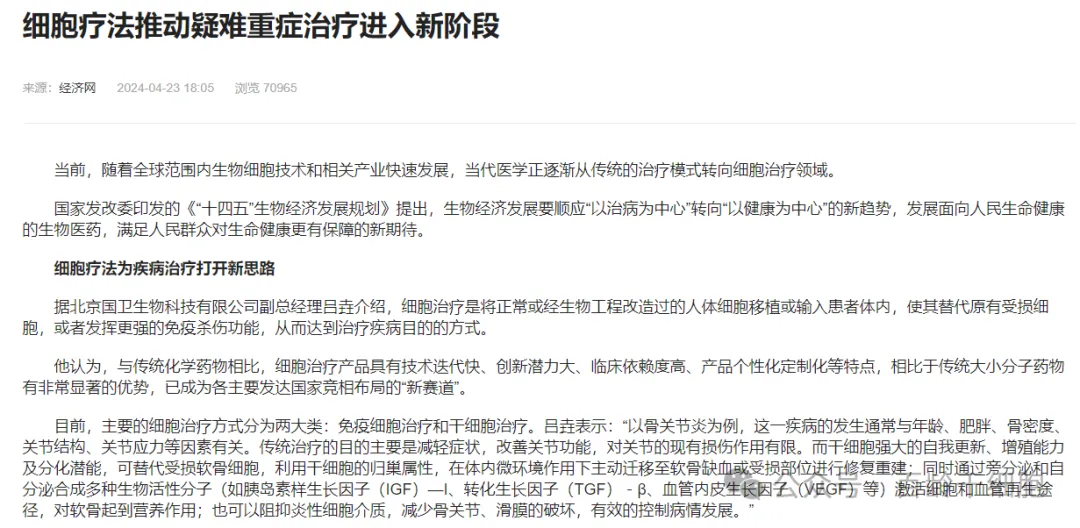
In recent years, the national level has attached great importance to the research and development and application of cell therapy, and provided strong support and guidance for its development through a series of policy documents.
Cell therapy refers to the transplantation or infusion of normal or bioengineered human cells into patients to replace damaged cells or enhance the immune function of the body, so as to achieve the purpose of treating diseases. According to the different treatment methods and applied cell types, cell therapy is mainly divided into two categories: immune cell therapy and stem cell therapy.
Policy support for the development of cell therapy
1. Recently, the official website of the people's Daily China Economic Weekly published an article pointing out that cell therapy promotes the treatment of difficult and critical cases to a new stage.
The "14th five-year Plan for Bio-economic Development" issued by the National Development and Reform Commission clearly puts forward that it is necessary to comply with the new trend of "taking disease treatment as the center" to "health as the center" and develop biomedicine for the life and health of the people. As an important part of biomedical field, cell therapy has a broad development prospect.


It is mentioned in this paper that compared with traditional chemical drugs, cell therapy products have the characteristics of rapid technological iteration, great potential for innovation, high clinical dependence and personalized customization of products, and have very significant advantages over traditional large and small molecular drugs. it has become a "new track" for the layout of major developed countries.

In particular, it is pointed out that at present, the main cell therapy is divided into two categories: immune cell therapy and stem cell therapy. Take osteoarthritis as an example, the occurrence of this disease is usually related to age, obesity, bone mineral density, joint structure, joint stress and other factors. The main purpose of traditional treatment is to reduce symptoms and improve joint function, but the effect on existing joint injury is limited. The strong self-renewal, proliferation and differentiation potential of stem cells can replace the damaged chondrocytes and make use of the homing properties of stem cells to actively migrate to the ischemic or damaged parts of cartilage under the action of microenvironment in vivo for repair and reconstruction. At the same time, through paracrine and autocrine synthesis of a variety of bioactive molecules (such as insulin-like growth factor (IGF)-I, transforming growth factor (TGF)-β, vascular endothelial growth factor (VEGF), etc.) to activate cells and vascular regeneration pathway, play a nutritional role in cartilage; it can also inhibit inflammatory cell mediators, reduce the destruction of bone, joint and synovium, and effectively control the development of the disease.
2. The National Drug Review Center issued "Technical guidelines for Pharmaceutical Research and Evaluation of Human Stem Cell products (trial)" and "Technical guidelines for Clinical Trials of Human Stem cells and their derived Cell Therapy products (trial)", it provides specific technical guidance for the research and development, production and registration of stem cell products, which helps to standardize the development of the industry and ensure the safety and effectiveness of the products.

3. In the opinions on further improving the Medical and Health Service system issued by the Department of Science, Technology and Education of the National Health Commission, it is also clearly proposed to strengthen the research on cutting-edge medical technologies such as stem cells and regenerative medicine, which provides policy support for the further development of cell therapy.


With the continuous progress of science and technology and the continuous strengthening of policy support, we have reason to believe that cell therapy will achieve more remarkable results in the future. Cell therapy is not only expected to bring new treatment options for difficult and critically ill patients, but also promote the innovative development of the biomedical industry and make greater contributions to the cause of human health.